On an otherwise quiet November morning, an actress at São Paulo’s Teatro Oficina was startled by the roar of engines and the sound of debris cascading down a hill in the empty lot next to the playhouse. Outside the massive window of the theater, she saw a truck and two yellow bulldozers pecking away at a pile of ruins that had rested there over the last four decades as remnants of one of the oldest neighborhoods in the heart of South America’s biggest metropolis. The machines, lethargic under the sun, went about their business unceremoniously flattening everything in their paths. “I’m here, in the shade of the tree planted by Lina Bo Bardi, looking through the window she made, at the first concrete attack on us,” the actress said in a video later posted on Facebook. That slow-paced footage of the bulldozers jerking back and forth like menacing sheep at pasture had an air of cruelty. “The mood is very hostile around here, so I didn’t go close to the machines. I don’t know what these workers came here to do or what they were told to do, but they’re preparing the land for something they want to build. It’s a sign of war and destruction.”1
The ruins crushed by those bulldozers formed a small hill in the middle of a vast expanse next to the theater. They were old tiles, bricks, and shingles from a row of houses that had once occupied that land, along with fragments of the first synagogue ever built in São Paulo. During some of the plays staged here by José Celso Martinez Corrêa, the playwright known as Zé Celso who has been at the helm of the theater since its inception, actors would sprinkle sunflower seeds over the ruins as a symbolic attempt to revive what had been ravaged by extra-dramatic forces. The entire block was razed in the 1980s when Grupo Silvio Santos, one of the biggest media conglomerates in Brazil, bought the land and paid each family there to vacate in order to build a cluster of residential towers. That project never broke ground, however, due to an ongoing dispute over what can be built next to one of Lina Bo Bardi’s most iconic and beloved buildings. Ever since the Italian-born modernist gave new life to the remains of a former theater destroyed by fire, the building and its surrounding area have been protected by federal, state, and city heritage laws.
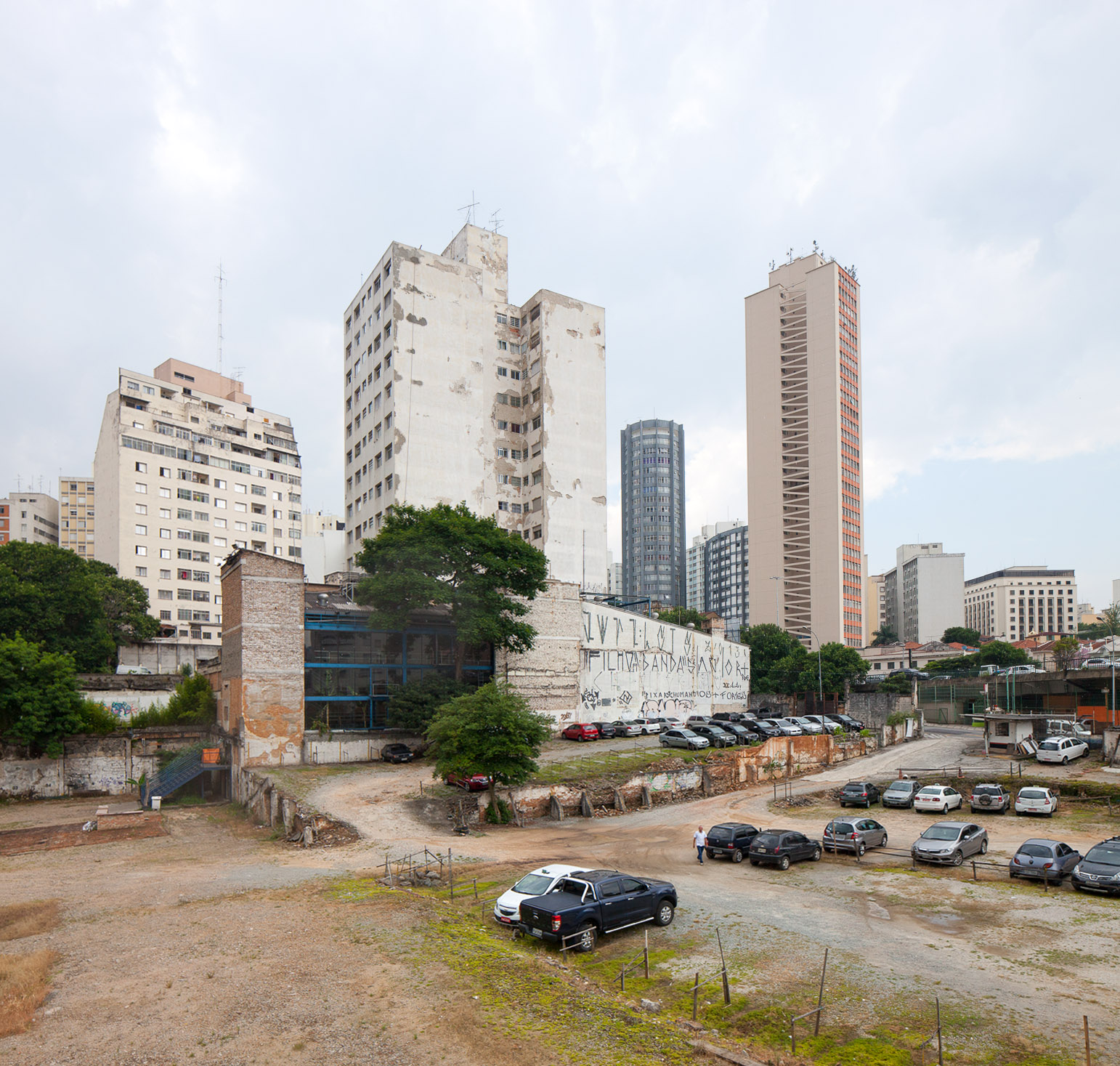
Oficina’s historical magnitude disguises its modest physical dimensions. Early sketches of plans for the lot next door show the theater dwarfed by three gigantic twenty-eight-story towers that would cast a perennial shadow over the stage and condemn it to a sense of perpetual real estate gridlock. It would signal the end of a cultural project that started in the 1950s, which served as an arena of political resistance against the military dictatorship that ensnared Brazil from the 1960s to the 1980s and blossomed anew as an aesthetic powerhouse when the country restored its bumpy democracy nearly four decades ago. This war or resistance of sorts, first against an authoritarian regime and then against the much more pernicious attacks of the real estate market in downtown São Paulo, was long framed by and played out through strong rhetoric and architectural blueprints on either side. Everything, until now, was hypothetical. But those bulldozers materializing on the landscape were the first undeniable signs that this war had turned very real.
Theater After Sturm und Drang
When Lina Bo Bardi began to draft the lines of the Teatro Oficina as it stands today, she asked herself what happens after Sturm und Drang, or the “tempest of irresistible ardor,” as she called the budding seeds of romanticism. That was how the architect remembered the fire that consumed the old Novos Comediantes Theater, a playhouse built on those grounds in the 1920s, where Zé Celso and his company began to stage their first plays three decades later. The building leased in 1958 by what then was still a group of rebellious law students from the most prestigious school in Brazil burned to a crisp in 1966, two years into the military regime’s rule.
Long before Bo Bardi’s intervention, the old theater featured the famous massive metallic door that separates it from Jaceguai Street, a downward slope squeezed between the playhouse and the elevated expressway that paulistanos call the Minhocão, or the big worm. Since its inception, Oficina was to be a “bunker of cultural resistance,” in the words of Edson Elito, who worked with Bo Bardi on the renovation.2 After Oficina’s first incarnation was ravaged by the flames, set designer Flávio Império helped fix it up just enough so that new plays could be staged. Bo Bardi herself stepped in to design the sets of O Rei da Vela and Roda Viva, groundbreaking productions that spelled out a fierce opposition to the dictatorship in between their scripted lines. Ironically, it was the iconoclastic power of those raw performances, largely incomprehensible to the obtuse, authoritarian political establishment of the time, which helped save Oficina in the beginning. While the architect didn’t begin to paint the watercolors that would turn into the blueprints for the new theater until 1984, Oficina’s protection throughout the dictatorship was enshrined into law three years prior, when state heritage authorities declared it “a cultural property of the city, not for its historical importance, but for its use as a stage for the transformation of Brazilian theater.”3 That transformation would then transcend the ideological charge of the onstage narratives, feeding back into the architecture fashioned for a new Oficina—one that would be at the same time an “electronic yard” for “technical barbarians,” as Zé Celso wanted, and a space drenched in simplicity akin to watching drama unfold from the sanctity of a church pew, as Bo Bardi first described it.4 In a sense, a fiery yet graceful clash of personalities spawned this magnetic, intimately cavernous arena. “The Oficina is not the portal to the Cologne Cathedral of the late 18th century, but it is an important milestone along a difficult road. The storm destroys, it is necessary to regroup and rebuild,” wrote the architect. “In architectural terms, the tempest destroyed all and the Oficina will act anew. Based upon the utmost simplicity and the greatest attention to the scientific means of contemporary communication.”5
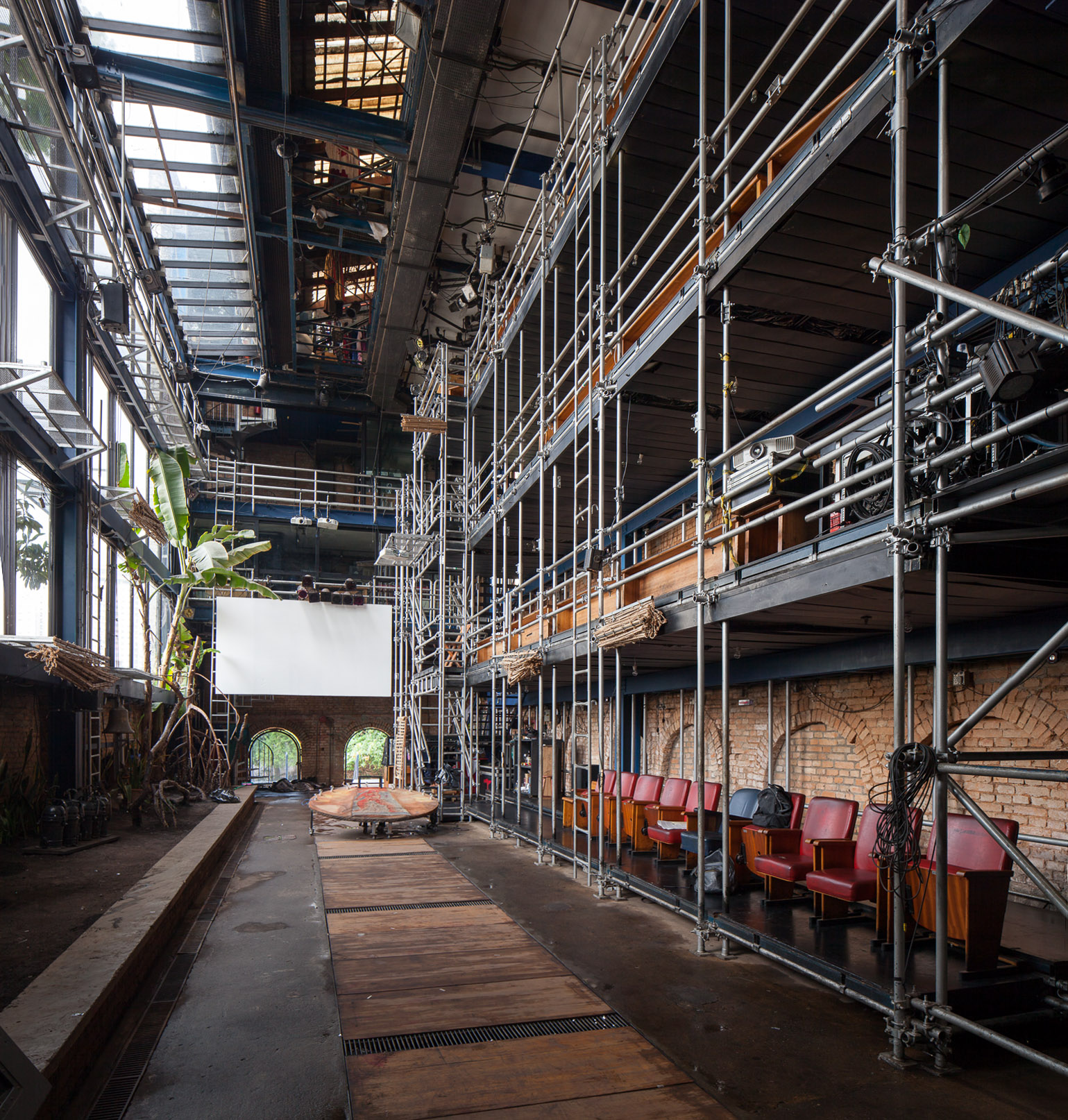
That charge required harnessing the power of two seemingly antagonistic forces to build the foundation for a theater that always wanted to scream revolution. On one side, as Edson Elito recalls, was the “modernistic schooling, the concepts of formal simplicity, the purity of elements, the idea of less is more, the constructive rationalism and the asceticism” of the architects.6 7 On the other lay Zé Celso’s “symbolism, iconoclastic, baroque cannibalism, the sense, emotion, and desire for physical contact between the actors and the audience.”8 Oficina was born of the friction between the austere clarity of Japanese Noh theater, as Lina Bo Bardi’s early sketches indicate, and the vision of theater as a Brechtian combat sport, in the vision of Zé Celso. This explains the physical space reminiscent of both a street and a ritual ground, where performers and audience are constantly moving up and down the metallic scaffolding, around a stage that is as much a sacred arena of muscular, full-throated dissent as it is a passageway. Zé Celso’s plays, which run upward of eight or nine hours with actors moving in and out of the theater, could be likened to what performers in the visual arts would consider acts of endurance. The resistance here is both physical and ideological, testing the boundaries of the architectural space that would contain it, which perhaps explains Bo Bardi’s decision to gut the building, demolishing all of its old internal walls to create a stage serving as a path between the street outside and the back of the lot, empty then and now, and open to the sky with a domed sliding steel roof overhead.
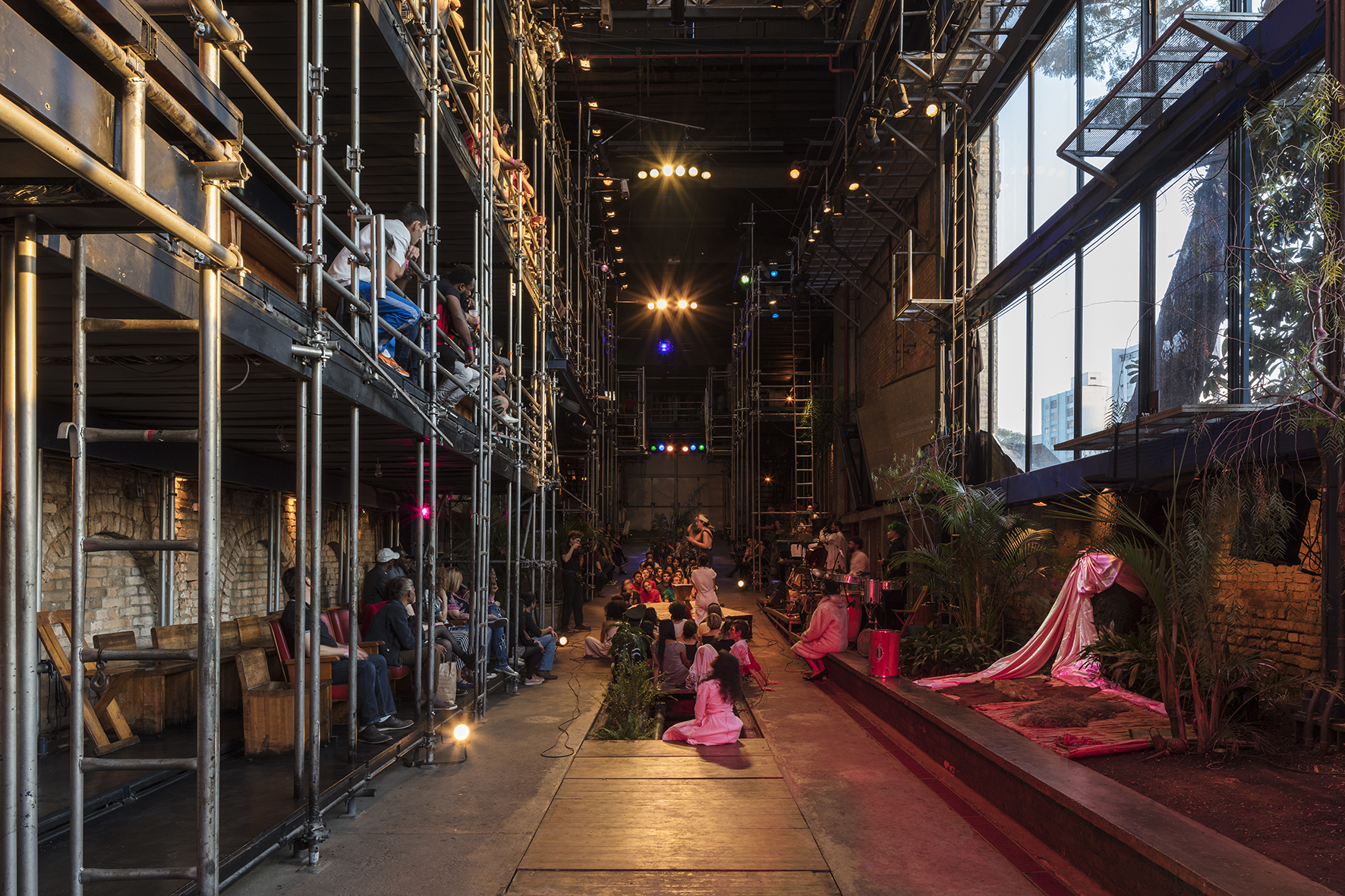
The contours of Oficina were drafted over wine at Bo Bardi’s famed Glass House.9 The architect’s home, on São Paulo’s far west side, is a transparent pavilion hovering dramatically above the forest of a garden she planted herself. The wild vistas of a then-sparse metropolitan refuge were visible from all sides and angles as the architects thought of ways to create a theater that would propel engagement with the audience, allow for absolute freedom of movement, and operate as a porous membrane between inside and outside worlds. To this day, the experience of watching a play at Oficina is unrivaled, as energy courses through all bodies onstage and off, mirroring a city that heaves and bursts in flashes of light.
In Bo Bardi’s original sketches, the lot surrounding the theater would remain empty with occasional demountable benches for spectacles that would always have the possibility of overflowing outside, in tune with the same ideas at the base of her Glass House and the Museu de Arte de São Paulo, or MASP, her translucent box of glass and concrete crowning the city’s Paulista Avenue. In addition to the multiple openings and the massive skylight and windows, the architect punctured a series of holes in Oficina’s walls, allowing for shafts of light to pierce the stage during the daytime, an allusion to the bombarded, hollowed-out buildings she had seen in her native war-torn Italy, the same image she would replicate in the design for the SESC Pompeia cultural center.10 This raw violence takes center stage at Oficina, a theater that seems anchored in the idea of beauty as a collision of forces. Its desire for total and absolute transparency, creating what its architects understood as a “unified scenic space,” is now the element most threatened by attempts to build on the lot next door.11
Clash of Titans
The two sides of the battle surrounding Teatro Oficina have very charismatic, boisterous, and experienced flag-bearers. On one side is the founder of São Paulo’s longest-surviving drama troupe, Zé Celso, a hippie who quit law school sixty years ago to create Uzyna Uzona, one of the most revolutionary ensembles ever to grace the stage in Brazil. Comparable to the live-action version of Oswald de Andrade’s “Cannibalist Manifesto” and Caetano Veloso and Hélio Oiticica’s Tropicália movement, Uzyna Uzona made Oficina its home from the very beginning. On the other side is Senor Abravanel, the business magnate and screen celebrity known to millions of Brazilians as Silvio Santos, a legendary game-show host; owner of SBT, the second biggest television network in the country; and one of the city’s most powerful entrepreneurs. Their standoff is seen by many as a clash of titans, a vicious and magnetic duel of high-brow culture against entertainment for the masses. In other words, underground theater rooted in dreams of a social, political, and sexual revolution are here threatened by a mogul of populist affection, a man who built a media and real estate empire in São Paulo by commanding masses of fans to gaze at their television screens every Sunday night as he folds money into neat paper airplanes only to send them flying toward his live audience. Each launch causes a flurry of action, as his fans dart to the studio floor in desperation, trying to pocket as many bills as possible. Onstage, at Oficina, Zé Celso often dresses up as Silvio Santos, mocking the TV personality portrayed as a money-hungry devil, a cruel dictator, or a heartless businessman ready to topple the theater to build a shopping mall, a hotel, or yet another tower crowding the last empty lots that resist occupation in São Paulo. His opponent’s multiple avatars have wound their way into all kinds of productions, morphing to fit the play at hand but never to the point that this personification of evil becomes unrecognizable. The plays at Oficina, in that regard, have always been ambitious, hot-blooded allegories mirroring the violence of Brazilian society, from the torture cells of the dictatorship to the wanton and reckless disregard for memory that has long held Brazilian culture in a stranglehold.
But the balance of power has been shifting beneath Zé Celso’s feet as the political establishment in Brazil has taken a sharp turn to the right. The fight to keep Oficina open, or at least operating with unobstructed access to the outside world, could soon come to an abrupt end. Late last year, a section of the laws that prevented Grupo Silvio Santos from building on their land next to the theater was revoked after much pressure from the media group. In November, Santos managed to convince heritage protection experts that building a massive structure right up against Lina Bo Bardi’s theater would not have a negative impact on the preserved construction, even though it would most likely block the gigantic window that makes the skyline of downtown São Paulo a luminous backdrop to every play staged there and turn the quiet alley where Oficina now stands into a traffic nightmare. This decision follows the same logic that not long ago permitted the construction of another massive office building next to a row of modernist houses, the first of their kind in São Paulo, designed by Ukrainian architect Gregori Warchavchik in the city’s historic Vila Mariana district. When that project broke ground, some of the walls of these two-level houses cracked with the land shifting right under them.
While Bo Bardi’s design for the theater is anchored in complete and total openness, with a stage that doubles as a path from the front sidewalk to the very back of the building, the logic at City Hall is different. Few details of the shady deals that would encourage the authorities to approve such an urban planning disaster have surfaced, though the outcry has been tremendous. Ever since permission for construction on the lot next door was granted, actors, writers, artists, and even some more left-leaning politicians have taken to the streets in protest. In one of these rallies, they stood arm in arm, forming a human barricade around Oficina should the bulldozers arrive.
The machines eventually made their much-feared debut not long after a strange meeting took place. Behind closed doors at the headquarters of the SBT television network, in a suburb of São Paulo, Silvio Santos, Zé Celso, and the city’s mayor, João Doria, each with his entourage, met to discuss a solution to the impasse that is about to reach its fortieth anniversary. No journalists were allowed to come near the talks, but soon a video of the meeting surfaced, revealing a conversation of farcical overtones.
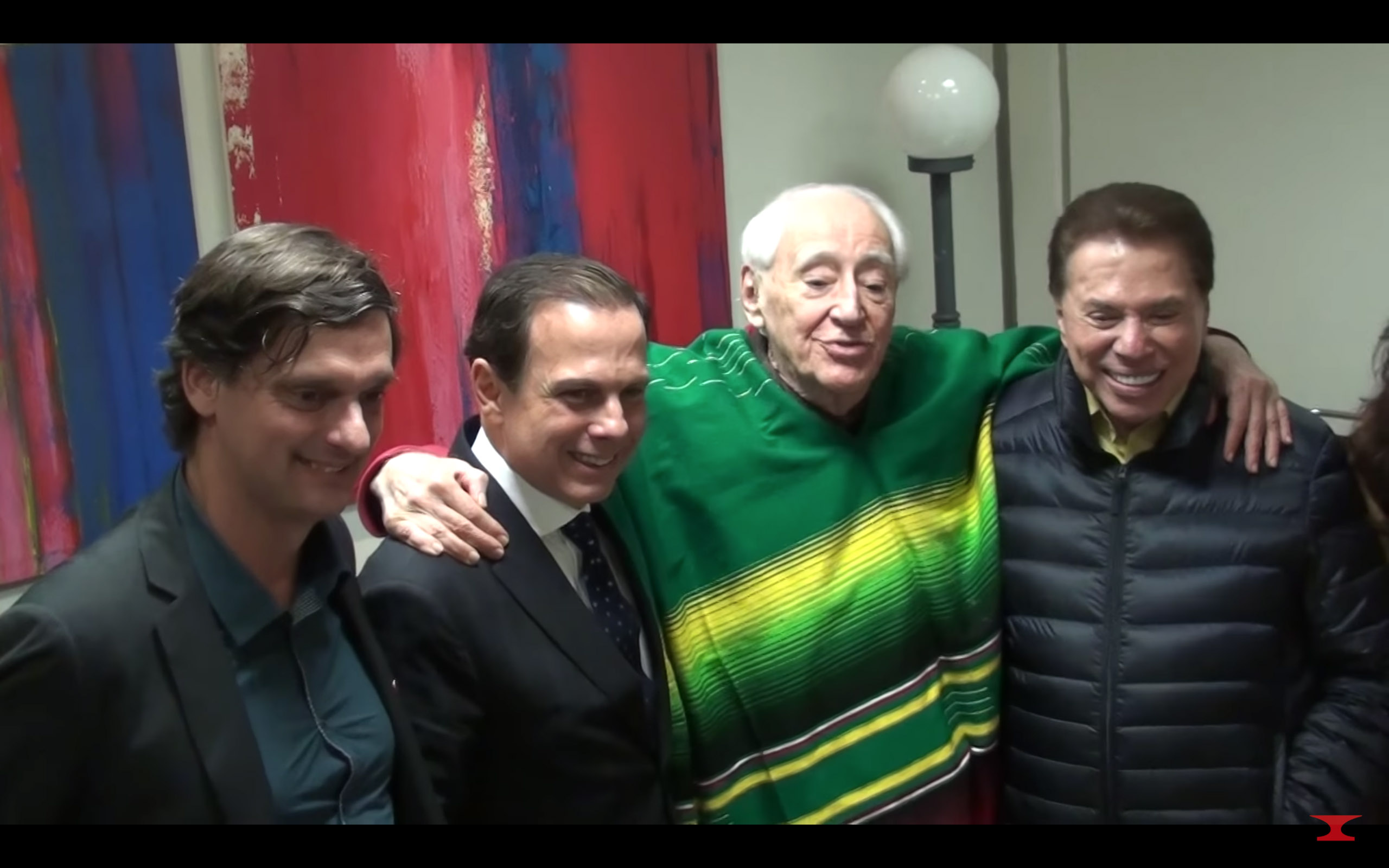
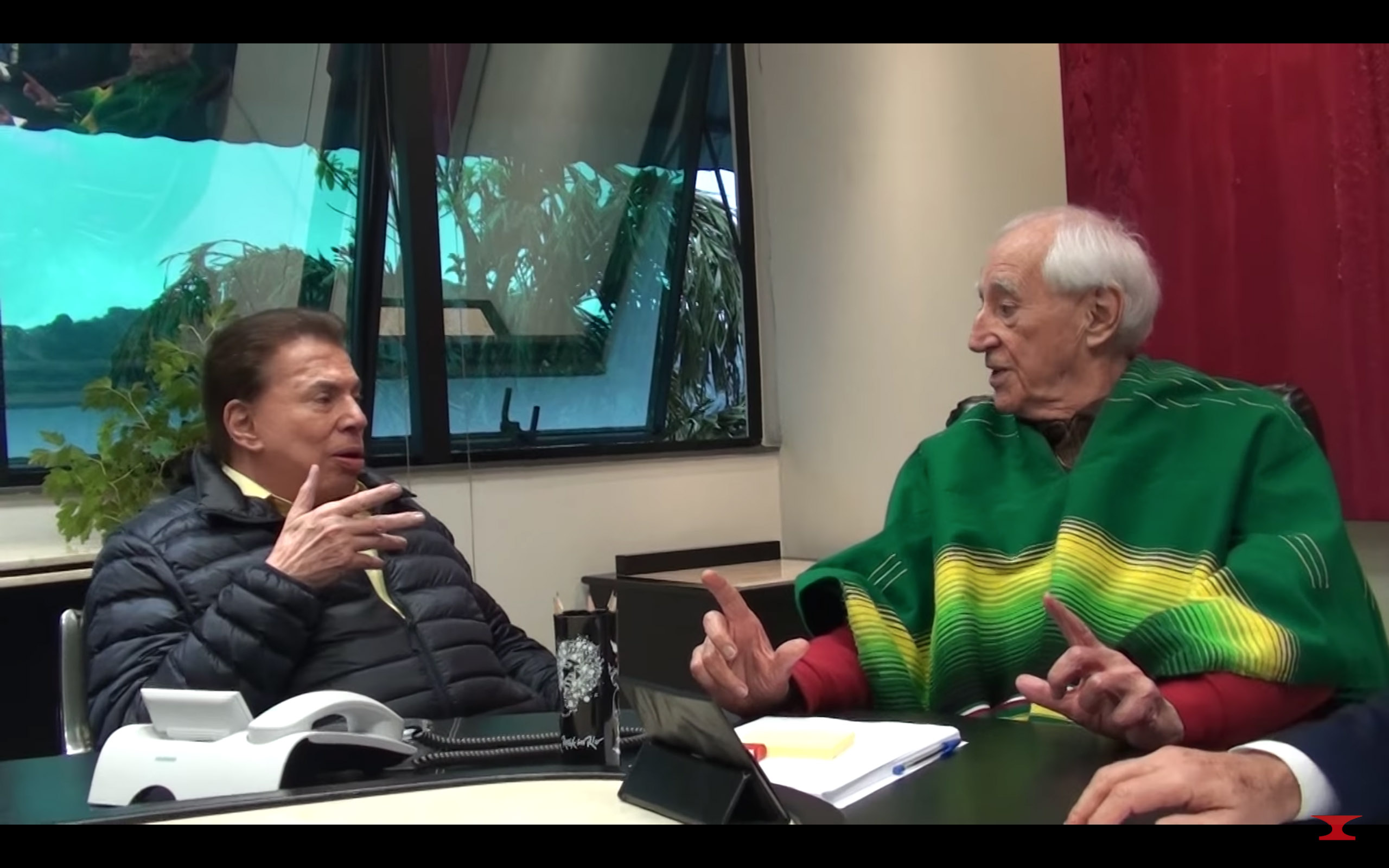
In a Mexican poncho, Zé Celso tried to convince Silvio Santos—smug in a sports jacket—to give up on his plans to build on the lot. “São Paulo will have a heart attack with so many towers and so many cars. This is the last empty spot in the city,” said the playwright. “I don’t want to build anything there; I want to leave it open, and we’ll set up tents for rock concerts, for the circus.”12 Silvio Santos laughs in response and tells him not to be delirious. “You’re dreaming; no one will give you this land for free. Even though I’m a rich man, I paid for that plot, and it’s my right to build on it; it’s not money I am willing to lose. And it’s not my fault that I’m rich. I got lucky, and you didn’t.”13 Doria, the mayor who is a former host of the Brazilian version of The Apprentice and who takes pride in being a rich man himself, then chimes in to suggest a compromise. His idea is to let Silvio Santos build not a group of towers but a shopping mall, “the kind they have in America,” he adds. 14 Other ideas aired on the table were a hotel, a group of stores, or even smaller buildings. An architect who works for Zé Celso, seated at the meeting, objected to the idea of anything of the sort, saying those words were just a “bit too harsh.” Silvio Santos, losing his patience, then threatened Zé Celso, saying he will let drug addicts from São Paulo’s infamous downtown slum known as Cracolândia take over the land to drain it of its real estate value. His closing argument was there should be no argument. “It’s not fair for someone to buy a plot of land and not be allowed to build on it. Isn’t this a democracy?”
“No,” said Zé Celso. “This is not a democracy ever since there was a coup d’état.”15
Fora Temer
Zé Celso was not talking about the April 1964 episode when a group of military generals overthrew the government of then president João Goulart. The latest coup d’état, in his opinion, was the 2016 ousting of Dilma Rousseff. The first woman installed in Brasília’s Alvorada Palace was impeached by opposition congressmen who alleged she had embellished government balance sheets to make the federal debt appear smaller than it was in reality, an irregularity many political analysts saw as not grave enough to merit such a drastic decision. The impeachment submerged the country in political turmoil. Michel Temer, until then a decorative vice president, rose to power emboldened by a clan of wealthy, old white men, many soon appointed to cabinet and ministry leadership positions. These representatives of the country’s most deeply rooted rural oligarchies then proceeded to dismantle labor protections and now struggle to push forward a pension reform that will condemn the working class to work to the very last year of current levels of life expectancy in Brazil while maintaining their own privileges. In this scenario, culture and heritage, historically not very high on the government’s priority list, have been thrust into the crosshairs once again.
While celebrated abroad, Lina Bo Bardi could now be the target of the hardest blow against her legacy yet, as it seems all the stars have aligned to allow the planned assault on Oficina to proceed. In the latest tragicomic round, the current president, clocking in with an approval rating lower than 3 percent, made an appearance at Silvio Santos’s Sunday game show, which used to be named Topa Tudo por Dinheiro, or Willing to Do Anything for Money, to defend his pension reform. Backstage, he confessed to being a fan of the host and, standing before the cameras, did not hesitate to throw money at the bleachers as he explained his pitch to restrict social security to a largely blue-collar audience. Temer is viewed by the country’s elite as a necessary evil to approve an agenda that had stalled under Luiz Inácio Lula da Silva, Brazil’s most popular—many say populist—president in history.

Lula, a monumental figure of Latin America’s left, ruled Brazil during its most prosperous years in recent history, riding on a wave of Chinese expansion and skyrocketing commodity prices. The financial bonanza of the Lula years also allowed for the implementation of social assistance programs that lifted forty million Brazilians out of poverty and witnessed a climate of financial stability that made the country’s wealthiest citizens even wealthier and paved the way for his largely unopposed reelection. But the mood began to sour with hiccups in the Chinese engine, a drop in commodity prices, and an ever-expanding national debt under his successor Dilma Rousseff, setting the stage for her removal from office orchestrated by that very same financial elite that had tolerated Lula as long as there were profits to be made. While Rousseff was not found guilty of committing any crimes and remains eligible for office despite her disgraced second term being cut short, Lula and most of Brasília have since been dropped into the bucket of Operation Car Wash, a federal police investigation that has implicated lawmakers, businessmen, and judges all across the political spectrum. The latest episode of this political soap opera came in January of this year when Lula was convicted on corruption charges for accepting a beachfront apartment from a construction company as a bribe in exchange for political favors. The former president’s lawyers and many highly regarded legal experts challenge those claims, alleging a lack of evidence and calling into question the suspect timing of such a decision. Lula’s case raced through Brazil’s typically lethargic judiciary at record-breaking speed, reaching a guilty verdict just in time to prevent him from running for a third presidential term in the country’s elections this October, for which polls had predicted his easy victory.
With Lula out of the electoral landscape and growing discontent over the largely unpopular current president, targeted with chants of “fora, Temer,” or “out with Temer,” in rallies and protests since he took office, Brazil is now approaching its most unpredictable elections since the return to democracy in the 1980s. In the power vacuum left by Lula, Jair Bolsonaro, an extreme right-wing candidate styled after Donald Trump with a pronounced nostalgia for the military regime and its practices of torture, is now leading the polls. His most likely competition consists of Geraldo Alckmin, the uncharismatic governor of São Paulo; Luciano Huck, another game-show host who made a fortune on television giving away prizes to the poor while cheering on crowds of scantily clad women; and Marina Silva, a champion of environmental protection with shady links to the conservative evangelical movement.
During Carnival, the riotous festivities that attract millions to the streets of Brazil in one of the biggest popular celebrations on the planet, this tattered state of national politics was everywhere to be seen. One samba school, as the official contenders in the parades in São Paulo and Rio are known, dedicated all of its floats to an attack on Temer, even depicting the president as a neoliberal vampire, a trickle of blood oozing from his mouth and a halo of money bills around his neck and a streaked beehive hairdo. Dancers paraded around as slaves in chains or giant shredded copies of the blue work permit issued to every citizen in allusion to labor rights being torn up. On television, talking heads aligned with this government’s strategy were mum, as though the parade were a commentary on a fictitious, hypothetical country. But the party ended with a bitter aftertaste, as Brazil now grapples with a real, deepening antagonism. It is in this climate that the debate over Oficina will unfold.
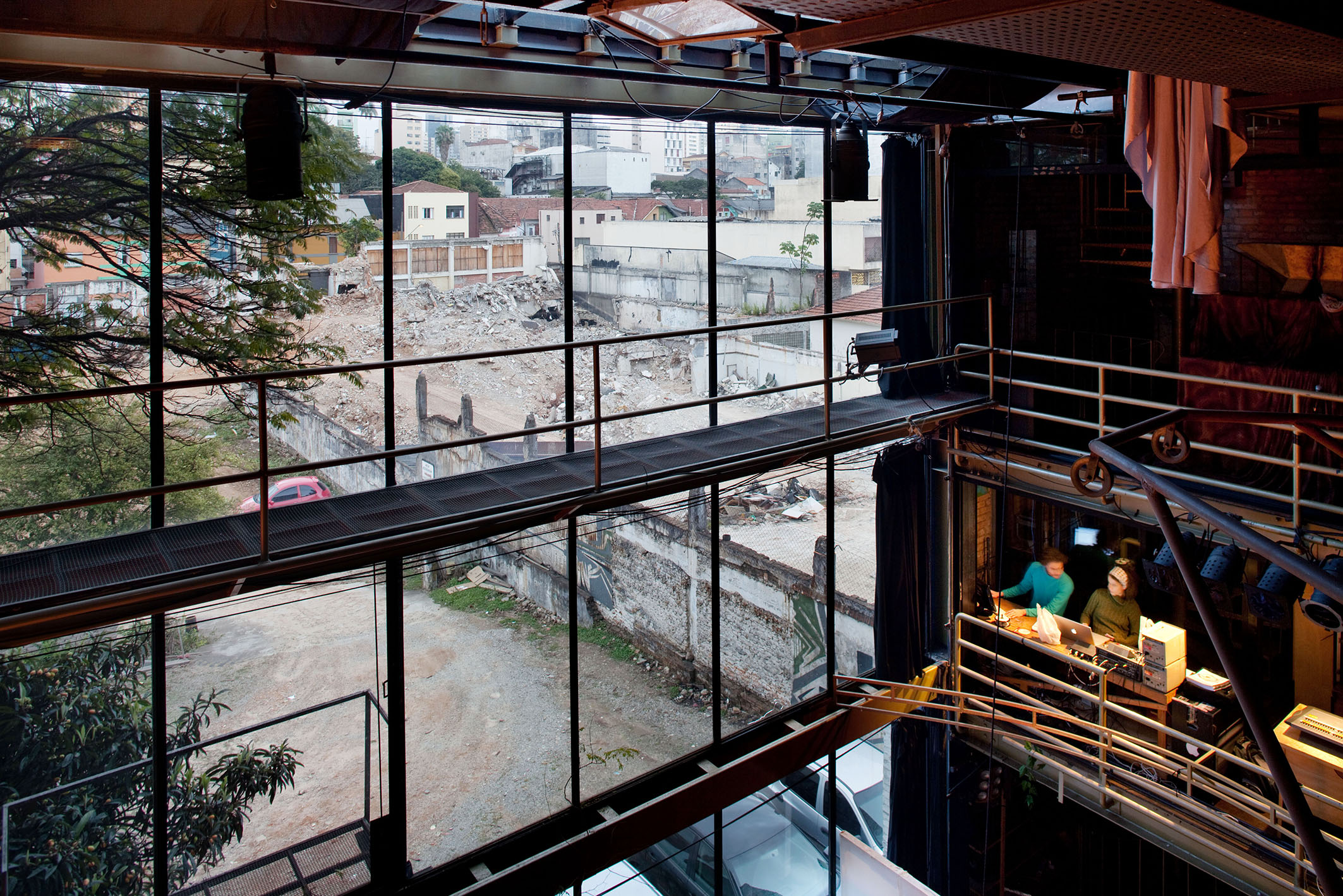
Modern Dramas
Brazil has a fraught relationship with the past. The idea that this is the country of the future, or that the best is yet to come, has been ingrained in the national psyche ever since the nation was invented. It is what drove the aggressive redesign of Rio de Janeiro’s natural landscape a hundred years ago, the quixotic construction of Brasília in the middle of nowhere, the demolition of the old coffee baron mansions along São Paulo’s Paulista Avenue, and the notion that the Teatro Oficina could be wrapped up and forgotten.
Planning decisions made behind closed doors in air-conditioned rooms, where personal interest overrules public concerns, spill out onto the urban fabric of the country’s cities with a violence that respects neither the past nor the future. Last year, São Paulo’s elite gushed over the inauguration of two glittering new cultural centers, the Paulo Mendes da Rocha–designed SESC 24 de Maio and a new museum tower on Paulista Avenue, the Instituto Moreira Salles, designed by the firm Andrade Morettin. But few wealthy art-world patrons have bothered to give the plight of Oficina the time of day. The message of the economic establishment is yes to the shiny and new, while the old is simply smothered.
Oficina is perhaps the most tragic victim of this logic. The Bela Vista neighborhood, where it stands next to an empty lot—one of the last undeveloped plots of land in São Paulo’s dense central core—has never figured more prominently in the imaginations of land speculators. While the city debates what to do with the nearby Minhocão, which some architects and activists would like to see transformed into a local version of New York’s High Line, the dive bars and brothels that used to line Augusta Street not far from there have already given way to sterile condos with names like “Hype Living.” Now, the houses of the old Italian immigrants who established Bexiga, as the neighborhood is affectionately called, are seen as pesky rubble standing in the way of cheaper luxury apartments. In the eyes of city administrators—and they hope in the glazed-over eyes of anyone else paying attention—the theater is no different. Topa tudo por dinheiro.
-
Teatro Oficina Uzyna Uzona, “A-Now!!! Grupo SS Destrói Sambaqui, Ícone Vivo, Histórico, do Sítio Arqueológico do Bixiga....” Facebook, 19:53, November 13, 2017, link. ↩
-
Lina Bo Bardi, Teatro Oficina (Lisbon: Instituto Lina Bo e P. M. Bardi, 1999), 11. ↩
-
Bo Bardi, Teatro Oficina, 12–13. ↩
-
Bo Bardi, Teatro Oficina, 6, 13. ↩
-
Bo Bardi, Teatro Oficina, 6. ↩
-
Bo Bardi, Teatro Oficina, 6. ↩
-
Edson Elito joined the efforts to renovate the Teatro Oficina along with Lina Bo Bardi, who spearheaded the project. He helped raise funds for the construction and documented the creative process behind the elaboration of the new version of the theater. ↩
-
Bo Bardi, Teatro Oficina, 6. ↩
-
Bo Bardi, Teatro Oficina, 13–14. ↩
-
Bo Bardi, Teatro Oficina, 6. ↩
-
Bo Bardi, Teatro Oficina, 14. ↩
-
Teatro Oficina Uzyna Uzona, “Reunião no SBT: Teatro Oficina, Zé Celso, Sílvio Santos, Suplicy e Dória (parte 01), ” YouTube, 17:43, October 30, 2017, link. ↩
-
Teatro Oficina Uzyna Uzona, “Reunião no SBT,” YouTube, October 30, 2017, link. ↩
-
Teatro Oficina Uzyna Uzona, “Reunião no SBT,” YouTube, October 30, 2017, link. ↩
-
Teatro Oficina Uzyna Uzona, “Reunião no SBT,” YouTube, October 30, 2017, link. ↩
Silas Martí is a writer and art critic based in New York, where he works as a correspondent for the newspaper Folha de S. Paulo, for which he has also been the staff arts writer since 2007. He was a Knight-Wallace Fellow at the University of Michigan in 2015 and is also working on his doctoral thesis in architecture and urban planning at the University of Sao Paulo. He is a regular contributor to publications such as Aperture, Artforum, ArtReview, and Even.

